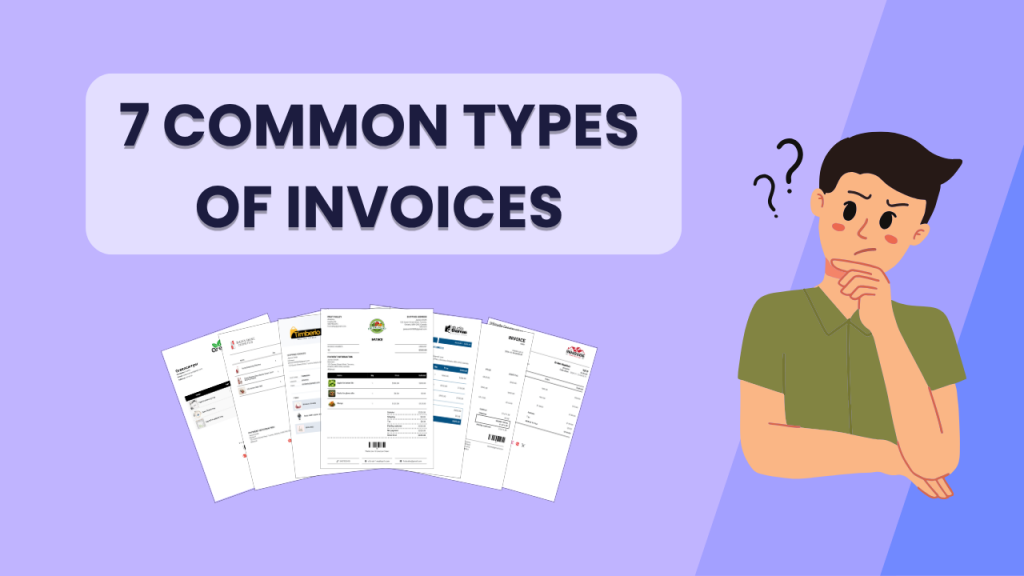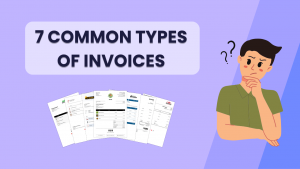Hey Merchants! As you know, getting paid on time is crucial for your business. But with so many different types of invoices out there – from standard to commercial, and everything in between – figuring out which one to send for your specific goods or services can feel like a puzzle.
Creating the right invoice is easy. Modern tools, like our Vify PDF Invoice App, effortlessly generate professional, customised invoices without any coding.
While Vify simplifies invoice creation, this guide focuses on the “what” and “why,” breaking down common invoice types and their specific uses. Understanding these will help you confidently select the perfect invoice for any situation, ensuring you get paid accurately and on time. Let’s explore them!

So, What Exactly is an Invoice?
An invoice is a seller’s document to a buyer requesting payment, detailing the transaction, cost, and due date. Typically sent after delivery or service, it’s vital for collecting payment. Invoices are also crucial for accounting, record-keeping, and customs, making them essential for all businesses.
💡 Important Note: While “invoice” and “bill” are technically different, customers might use them interchangeably. Clear communication with your buyer about this document is key to avoiding any confusion.
Here are 7 popular types of invoices you might come across. Below, we’ll walk you through each one so you’ll know what it is and when to use it.
1. Standard invoice – “Regular” types of invoices
Think of this as your everyday bill. It’s the most common type you’ll send to customers to ask for payment.
You’ll typically send this out to collect what’s owed right after you’ve delivered goods or finished providing a service.
This invoice clearly lists:
- Your business details and the customer’s details.
- An invoice number (for your records).
- What they bought (items or services).
- The total amount they owe you.
- When the payment is due (payment terms).
- How they can pay you (e.g., bank details).
Once paid, it also acts as legal proof of the sale. For most businesses, this simple and flexible invoice is all you need.
2. Commercial invoice
These special types of invoices are crucial when selling items to other countries. It helps you get paid by overseas buyers and lets customs figure out any taxes owed.
You must use it for all international shipments to follow trade rules and ensure everything goes smoothly
This invoice clearly shows the final price, including shipping costs, and often includes “HS codes” – universal product IDs that customs worldwide use to categorise goods and apply correct taxes. Tools like Vify can simplify adding these codes for faster clearance.
It’s vital that all details on this invoice are perfectly correct. Customs needs accurate information so your items don’t get stuck or delayed, and it’s often a required document for items to enter another country.
Customs officials use this invoice to let your goods into the buyer’s country and to work out the necessary taxes. This document also serves as your important legal proof of the international sale.
Always check what the buyer’s country specifically needs. Some places might have their own special forms or particular rules you need to follow for this important document. Read more details about the commercial invoices on trade.gov.
3. Pro Forma invoice
A Pro Forma Invoice is like a first draft of your invoice. You send it to customers before goods are shipped or work begins, showing what they’ll get and the approximate cost, ensuring you’re both on the same page.
This allows your customer to review details, see the estimated price, and discuss any changes before the final sale. For international shipping, it helps estimate customs fees, but remember, it’s not the final, official invoice.
You’ll use a pro forma when confirming a large order with a customer, or when declaring the value of exporting or importing goods to customs. It’s also key when bidding on a project or before starting work for a client far away.
It lists items like what’s being sold, quantities, the likely price, and when it might arrive. The customer then checks this preliminary invoice and tells you if it’s okay to proceed with the order or project.
4. VAT invoice
The VAT Invoices are special types of invoices show all the details of the sale, including this tax.
You use when sell something that has a sales tax called VAT (Value Added Tax) on it
It does the same job as a standard invoice, but it also adds all the important sales tax information that the VAT rules say you must show.
If a business that is registered for VAT sells something (that isn’t tax-free) to another business that is also registered for VAT, they have to give this VAT invoice. These types of invoices clearly show the VAT tax rate and the total amount of VAT for that sale.
5. Overdue invoice
An overdue invoice is simply an invoice that your customer hasn’t paid on time. When you send an invoice, it usually says when the payment is due.
If the customer doesn’t pay by due date, the invoice becomes overdue. (according to Zoho)
When an invoice is overdue, the business that sent it will usually send a reminder. This reminder is like the original invoice but might also mention any extra charges for paying late, like a late fee or interest.
Businesses send these reminders as soon as a payment is missed. If the customer still doesn’t pay after reminders and seeing potential late fees, the business might have to think about other options, like taking legal steps, or in some cases, they might decide to just cancel the order.
6. Credit invoice
A credit invoice, also known as a credit memo or credit note, is a document a seller sends to a client. It informs them they are receiving a reimbursement or credit, often to correct a previous invoicing error or issue a refund.
These types of invoices always display a negative total amount; for example, if a $50 refund is issued, the credit invoice would show -$50. Sellers should always generate this document to accurately record such transactions.
You’ll use a credit invoice when there are issues in the customer’s favour, such as invoice errors, damaged goods, order delays, or missing items. It’s also used for customer overpayments, returned items, or when an order is cancelled.
Additionally, a credit invoice is issued if a customer receives a discount after they have already paid the full amount. Essentially, it’s for any situation where a credit or refund needs to be formally given back to the client.
7. Debit invoice
A debit invoice, also called a debit memo or debit note, is used by a business to inform a client that they owe more money. It’s for adjusting a previous invoice upwards.
This document is different from a sales invoice because it modifies an existing invoice total, rather than billing for a new sale. Debit invoices always show a positive number.
You’ll issue a debit invoice when:
- A customer increases their order quantity post-invoice.
- You need to correct undercharges or miscalculations (like tax or delivery fees) on a previous invoice.
- New, agreed-upon costs (e.g., shipping upgrades) arise after the initial invoice.
- You’ve provided additional work or services not covered in the original invoice.
Understanding the difference between 7 types of invoices is key to smooth financial operations. And when it comes to actually creating and managing them, tools like Vify can really simplify the process, letting you focus more on your business and less on paperwork.







